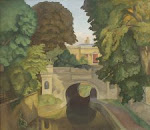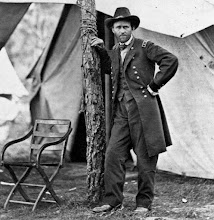At times, autumn has a dream-like feel to it. This may have something to do with its mix of changefulness and stillness, a quality that I mentioned in a recent post. Moreover, as is the case with any good dream (as opposed to a nightmare), we are reluctant to leave it behind.
How lovely it would be to be forever fixed in a grove of yellows and oranges and reds, the leaves trickling down as squirrels gambol overhead. On the other hand, the essence of autumn's beauty is its disappearance, isn't it?
John Piper, "The Bridge at Tyringham, Buckinghamshire" (1940)
November Dream
I wake to sycamore's yellowing leaves against the grey
Of cloud and London brick,
Day's solid walls and faintly luminous sky;
And still I almost see, in mind's eye,
Last night's woodland way
I followed under boughs of gold
Bathed in another light than these
That stand outside my window's narrow space.
No separation set me there, as here, apart
From dream's afresh-created sky and trees.
In that remembered country I was there indeed
While here, in body locked away,
Touch solid wood, wet leaves, earth-coloured flowers
And all is other that I feel and see;
Yet this world we call real, that has no place.
Kathleen Raine, The Oval Portrait (1977).
John Piper, "Exterior of the Church of St Denis, Faxton" (1940)
Saturday, November 10, 2012
Subscribe to:
Post Comments (Atom)





12 comments:
You’ve cracked the autumn nut most elegantly there, Mr. Pentz. And how you arrange to make Raine’s transcendent poem fit so neatly into the style and tone of your site is a particularly artful example of how one is never dealing with “poems I enjoy” with you.
The poem itself stuns me. It has that Stevensian clarity of looking at the moon (and its promises) in the light of the sun, but it extends beyond that to a hidden world of truth and longing left to hang in auric orbit like the best Japanese poems, plus it has that rich English detail and diction that makes it tangible as … well, dirt.
A wonderful, wonderful gift of a post.
Stephen,
I grew up in Chicago, which is possibly why I have a very different view of November.
The fall colors had gone by November. Only bare trees remained--browns and blacks predominated. It was cold and damp and gloomy, too warm for snow to cover the barren soil with its colorless dead leaves and dry grasses and flowerless stems.
It was the waiting room for winter, and not a pleasant one at that.
Long-time reader, first-time commenter here. I enjoy your blog very much, but there were a couple of things about this particular post that made me want to post some small remarks by way of response.
First is that I happen live close to Tyringham, so of course my attention was caught by the picture. A short while ago I happened to notice that Piper had also painted a church even closer to my home than the bridge at Tyringham: St Peter's at Stanton Low.
http://collections.vam.ac.uk/item/O1105552/stpeters-church-stanton-low-recording-watercolour-piper/
The V&A records say that the two pictures were painted in the same month -- April 1940. Always isolated, St Peter's is now a ruin in open fields between the village of Haversham and Milton Keynes, the new town whose construction was started in the late 60s and which now has a population of roughly 200,000.
The picture of the church at Faxton in the neighbouring county of Northamptonshire also struck a chord. I recently returned to Byron Rogers' The Last Englishman, a biography of JL Carr, best known for having written A Month In The Country. Rogers' excellent book covers Carr's one-man campaign to prevent the local diocese from abandoning the village church at Newton, near Kettering in Northamptonshire -- the church he later used as the model for that in A Month In The Country. Carr was especially determined to save Newton because Faxton church had recently been demolished. My favourite part of Rogers' book relates to when Carr encountered St Denis', Faxton, for the first time:
"'I first came across it in 1947…" It was 1993, the year before his death, and he was writing the foreword to Churches In Retirement, a gazetteer of redundant churches. 'It was July and I was walking from Rugby across Northamptonshire to my wife's home in Essex.' He does not elaborate on this remarkable statement."
Mr. Sigler: thank you very much for the kind words. It would be rude not to accept praise, but anything I do is only grappling through a dark wood, with an occasional gleam of light popping through.
As for Raine's poem, I must confess that her work often escapes me, although I do find it lovely. As you know, her big influence is Blake, and she has a mystical, dreamy, symbolic side that I have a hard time getting a handle on. But I try to accept her work as it is, and not impose my limitations on her -- as you know, I tend to favor the more direct approaches of people like Larkin and Edward Thomas. But I try to keep an open mind, I hope.
Thank you again.
Fred: your comments describe quite well my childhood memories of March in Minnesota: a greyness and a deadness that I still remember quite well, and that always strikes me when I visit there at that time of year. But at least spring is on the way in March, as opposed to November and the coming winter. I can understand why you would have a bleak memory of November in Chicago.
As always, it is good to hear from you.
Anonymous: thank you very much for being a long-time visitor, and for your comments today, which are wonderful to hear.
I have posted on J. L. Carr before, and I am a great admirer of his work, particularly A Month in the Country. I have read Rogers's biography of Carr -- which I agree is excellent -- but I had completely forgotten about the reference to St Denis (St Denys) and Faxton. I have the book in front of me as I write this, and find the passages you refer to at pages 178 to 180. As you know, Carr mentions that "only a few years earlier, John Piper . . . had passed that way."
I greatly appreciate your pointing out Carr's connection with the church and with Faxton: it adds a new dimension to Piper's watercolour. And I appreciate as well your pointing out your connection with Tyringham and its bridge, as well as with St Peter's at Stanton Low: again, it adds a new dimension that I would not otherwise have had.
The V&A "Recording Britain" archive is wonderful, isn't it? That project was a marvelous idea, and I am happy that the V&A has preserved its products so well.
Again, thank you very much.
Stephen,
Ah, now March is a different story. Chaotic! Windy, rainy at times,
sun shining fitfully through clouds. March was an awakening after February. Things were happening, and hope was in the air.
Fred: your descriptions of Chicago remind me of reading Saul Bellow. Although I have only visited Chicago a few times, I feel that I know about it a little bit through reading his work -- and now through your comments.
Thanks for dropping by again.
There is an additional and urgent reason for the poignancy of autumn this year for your UK readers. Ash blight has been discovered and it is likely that there will be significant loss of this beautiful tree, changing our landscape forever.
I was delighted by the comment referring to the biography of JL Carr which I read recently. A most interesting study of a very cryptic man. I have a number of books from his Quince Tree Press given to me by my late father in law.
alice c: I'm sorry to hear of the ash blight -- it's the first I've heard of it. I hope that they do not go the way of the elms.
Yes, J. L. Carr was a remarkable person. I agree with you that "cryptic" is a fine way to describe him. "Eccentric," for example, doesn't do him justice. A mystery remains about him that goes far beyond eccentricity. I greatly admire the way he lived his life.
Thank you for stopping by again.
Just to follow up on my earlier comment mentioning St Peter's, Stanton Low, the now-ruined church painted in 1940 by John Piper. I've recently discovered that a group has been set up with intention of saving the ruins from further neglect and making the area safe for visitors (the site is currently fenced off due to the precarious state of the remaning structure). The Save St Peter's Church Group has a simple website at http://www.savestpeterschurch.com/
Anonymous: thank you very much for the follow-up information, and for the link. It is good to see this effort taking place. Thanks for stopping by again.
Post a Comment